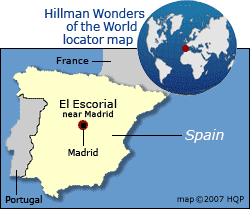El Escorial
 Why
El Escorial
is special
Why
El Escorial
is specialThe massive El Escorial countryside building contains - under one roof - a striking royal pantheon, palace, monastery, basilica, library, school, and art collection.
Top 5 El Escorial attractions
Royal Crypt
All but three of the kings that ruled Spain over the past five centuries are interned in this ornately stunning mausoleum.
Basilica
Its high altar and backdrop are decorated with gold and precious artwork.
Library
Rare historic books and manuscripts fill this richly decorated room.
Art Galleries
You see works by master artists including Titian, Velasquez and El Greco.
Philip II Chambers
Philip II Chambers The relative simplicity of King Philip's living quarters in Escorial reflects the lifestyle of this powerful, deeply religious king.
Why it was built
King Philip II built El Escorial (1557-84) for many purposes, including as a final resting place for his royal parents, himself, and his kings-to-be descendants.
More El Escorial tips and insights
How to pronounce
Escorial: Ehl Es-kohr'-ee-uhl
How it got its name
The El Escorial complex was named for the nearby town of Escorial.
Exterior vs. interior
The austerity of the El Escorial exterior granite structure (see photo) gives scant hint of the resplendent rooms that lie inside.
Nearest major city
You can visit El Escorial as a day trip from Madrid. It's only 40 kilometers (25 miles) away.
Location in Spain



